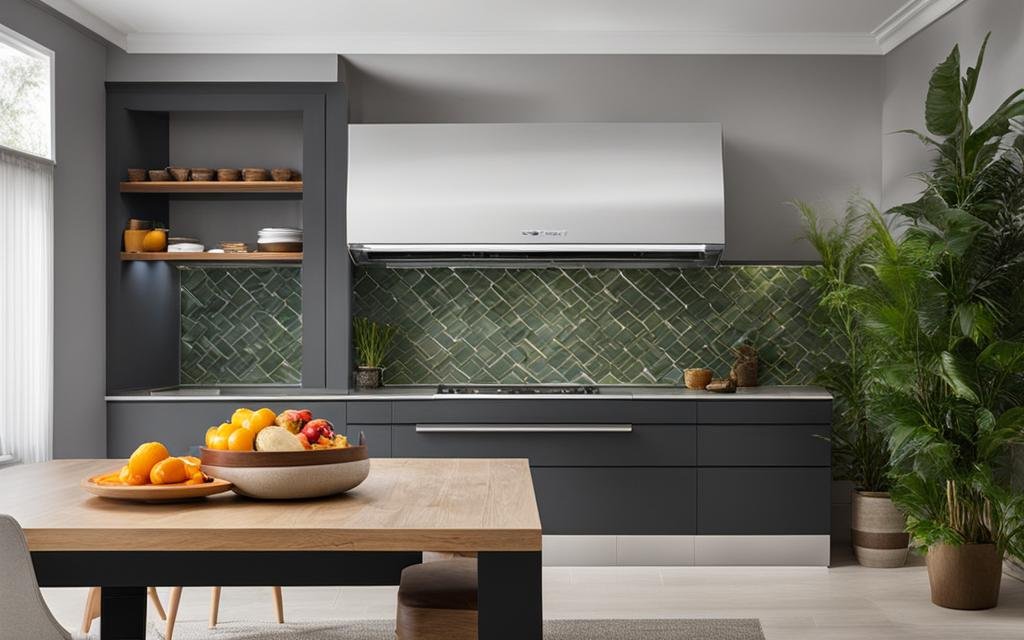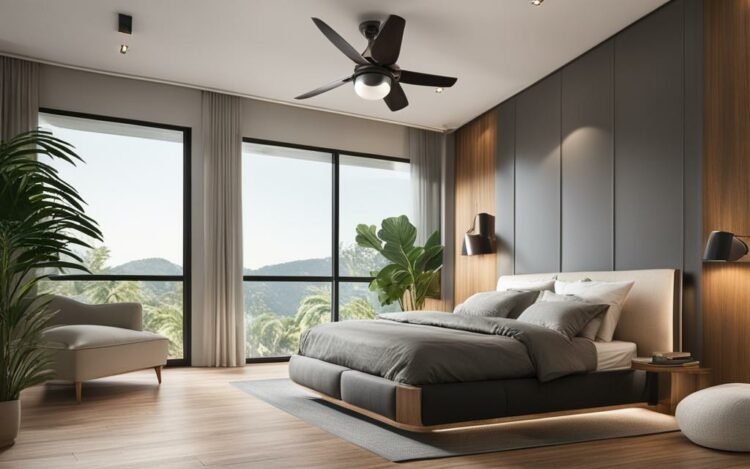Cooling and air quality systems are essential for creating a comfortable and healthy environment in our homes and workplaces. Whether you’re in need of air conditioning solutions, air purifiers, or HVAC systems, this comprehensive guide will provide you with the knowledge and insights you need to make informed decisions. From understanding the different types of cooling systems and air purifiers to choosing the right system for your needs and maintaining it for optimal performance, we’ve got you covered.
Key Takeaways:
- Cooling and air quality systems play a crucial role in ensuring a comfortable and healthy environment.
- Understanding the different types of cooling systems can help you choose the right one for your needs.
- Air purifiers, dehumidifiers, and humidifiers contribute to better indoor air quality and respiratory health.
- Consider factors such as system size, energy efficiency, and cost when choosing cooling and air quality systems.
- Maintaining your systems through regular cleaning and professional check-ups is essential for optimal performance.
Understanding Cooling Systems: Types and Operation
When it comes to cooling your indoor spaces, it’s important to understand the different types of cooling systems available and how they operate. This knowledge will help you choose the right system for your needs and ensure optimal comfort in your home or workplace.

The types of cooling systems
There are three main types of cooling systems: central air conditioners, ductless mini-split air conditioners, and evaporative coolers.
- Central air conditioners: These systems cool the entire home and require a duct system to distribute the conditioned air. They are a popular choice for larger homes or spaces that require consistent cooling throughout.
- Ductless mini-split air conditioners: These systems offer flexibility by cooling individual rooms or zones. They don’t require ductwork and are great for smaller spaces or for those who want to have control over which areas to cool.
- Evaporative coolers: Also known as swamp coolers, these systems use the natural process of evaporation to cool the air. They are cost-effective options, especially in dry climates, as they add moisture to the air while cooling it down.
How cooling systems operate
Cooling systems work by removing heat from indoor spaces and expelling it outside. They use refrigerants, compressors, condensers, and evaporators to facilitate the heat transfer process. The specific operation may vary depending on the type of cooling system you choose, but the end result is the same: a comfortable and cooler indoor environment.
Now that you have a better understanding of the types of cooling systems and how they operate, you can make an informed decision about which one is best suited for your needs. Consider factors such as the size of your space, energy efficiency, and climate when choosing a cooling system to ensure maximum comfort and efficiency.
Improving Indoor Air Quality: Air Purifiers and More
When it comes to creating a healthy and comfortable living space, the quality of the air we breathe plays a vital role. Indoor air quality can be affected by various factors, including pollutants, allergens, and humidity levels. Fortunately, there are air quality systems available, such as air purifiers, dehumidifiers, and humidifiers, that can help improve the air you breathe.

Air Purifiers
Air purifiers are designed to filter out airborne particles, including dust, pollen, pet dander, and even bacteria and viruses. These devices work by capturing these particles in a filter, preventing them from circulating in the air. Air purifiers are particularly beneficial for individuals with allergies, asthma, or other respiratory conditions, as they can help reduce symptoms and improve overall respiratory health.
Dehumidifiers
High humidity levels can create a breeding ground for mold, mildew, and other allergens. Dehumidifiers help to reduce moisture levels in the air, making it less favorable for the growth of these pollutants. By maintaining optimal humidity levels, dehumidifiers contribute to a healthier indoor environment and can help prevent issues such as mold-related allergies and respiratory problems.
Humidifiers
In dry climates or during the winter months, the air can become excessively dry, leading to issues such as dry skin, nasal congestion, and irritated respiratory passages. Humidifiers add moisture to the air, helping to alleviate these problems and create a more comfortable living environment. By balancing humidity levels, humidifiers can also help reduce the risk of airborne viruses thriving in dry air.
By incorporating air purifiers, dehumidifiers, or humidifiers into your home, you can significantly improve indoor air quality, promote better respiratory health, and create a more comfortable living space for you and your loved ones.
Choosing the Right Cooling and Air Quality Systems
When it comes to selecting the right cooling and air quality systems for your home or workplace, several factors come into play. Making an informed decision is essential to ensure optimal performance, energy efficiency, and cost-effectiveness. Here are some key considerations to keep in mind:
- System Size: The size of your space directly impacts the cooling capacity required to maintain a comfortable environment. Proper sizing is crucial to avoid overworking the system or inadequate cooling.
- Energy Efficiency: Look for cooling and air quality systems with high energy efficiency ratings. The Seasonal Energy Efficiency Ratio (SEER) for cooling systems indicates their efficiency. Higher SEER ratings translate to lower energy consumption and cost savings in the long run.
- Cost: Consider both upfront costs and ongoing maintenance expenses when selecting a system. Evaluate your budget and weigh it against the long-term benefits and savings offered by the chosen solution.
- Types of Pollutants: Identify the types of pollutants present in your indoor environment. This can include dust, allergens, pollen, pet dander, volatile organic compounds (VOCs), and more. Different air quality systems target specific pollutants, so understanding your needs will help you choose the most effective solution.
By carefully considering these factors, you can make an informed decision that suits your specific requirements. Remember to consult with professionals who can assess your space and provide expert advice on the best cooling and air quality systems for your needs.

Maintaining Your Cooling and Air Quality Systems
Proper maintenance is vital to ensure the longevity and optimal performance of your cooling and air quality systems. By following a few simple steps, you can keep your systems running smoothly and effectively for years to come.
Regular Cleaning
Regular cleaning is essential to remove dust and debris that can accumulate on various components of your systems. Clean the condenser coils of your cooling system to improve its efficiency and prevent overheating. Additionally, regularly clean or replace the air filters in both your cooling and air quality systems to maintain optimal air flow and reduce the accumulation of pollutants.
Professional Check-up
Schedule regular professional check-ups for your cooling and air quality systems. A trained technician can inspect and service your systems, identifying any potential issues before they escalate and ensuring that all components are functioning properly. This proactive approach can help prevent costly breakdowns and extend the overall lifespan of your systems.
Filter Replacement and Inspection
Regularly replace the filters in your cooling and air quality systems according to the manufacturer’s instructions. This will help maintain clean and healthy air in your home or workplace. Additionally, inspect the ductwork and insulation of your cooling system to ensure there are no leaks or damages that could compromise its efficiency.
Troubleshooting Common Issues
If you encounter any issues with your cooling or air quality systems, it’s important to troubleshoot the problem promptly. Check for common issues such as clogged filters, tripped breakers, or malfunctioning thermostats. If the problem persists or you are unsure how to resolve it, contact a professional technician for assistance.
By following these maintenance practices, including regular cleaning, professional check-ups, filter replacement, inspection, and troubleshooting, you can ensure that your cooling and air quality systems continue to operate efficiently and effectively, providing you with clean and comfortable air for years to come.
Conclusion
Cooling and air quality solutions are essential for creating a comfortable and healthy living environment. This comprehensive guide has provided valuable information on various aspects, including the different types of cooling systems and air quality systems, their benefits, factors to consider when choosing a system, and maintenance tips.
By implementing the knowledge shared in this guide, you can enjoy the benefits of improved indoor air quality, enhanced energy efficiency, and a comfortable living space for you and your loved ones. Choosing the right cooling and air quality systems that meet your specific needs is crucial. Consider factors such as system size, energy efficiency, and types of pollutants in your home to make informed decisions.
Furthermore, regular maintenance is key to keeping your cooling and air quality systems operating at their best. Schedule professional check-ups, perform regular cleaning, and replace filters as recommended. By following these maintenance practices, you can extend the lifespan of your systems and ensure optimal performance in providing high-quality air conditioning and improved indoor air quality.
Thank you for reading this comprehensive guide on cooling and air quality solutions. We hope that the information provided has helped you gain a better understanding of these systems and how they can benefit your home or workplace. Enjoy the benefits of a comfortable, energy-efficient, and healthy living environment with the right cooling and air quality solutions!

